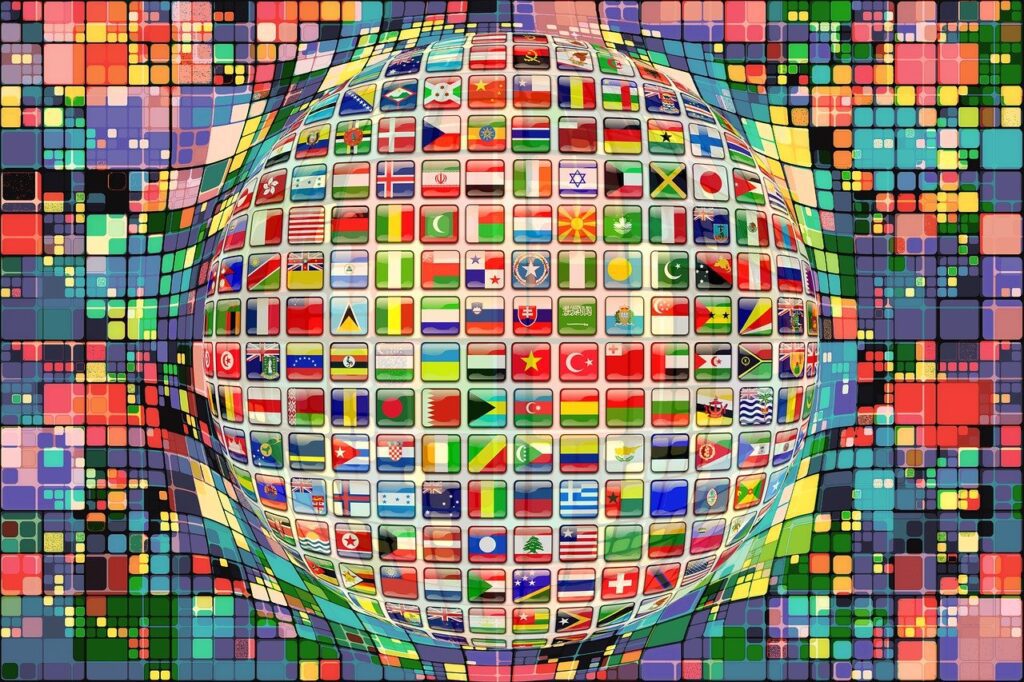Disclosure:
Some of the links on this website are affiliate links, which means that if you click on one of the links and sign up or make a purchase, we may earn a small commission at no additional cost to you. This commission helps support the maintenance and operation of this site.
We only recommend products or services that we believe will provide value to our readers. Our opinions and recommendations are based on our own research and experiences, and we strive to offer honest and unbiased content.
Please note that your support through these affiliate links is greatly appreciated, as it helps us continue to provide quality content and resources.
Thank you for your support!
An Overview
Global marketing is the practice of promoting and selling products or services across multiple countries and cultures. It goes beyond domestic borders to reach a global audience while adapting marketing strategies to suit each local market. In today’s interconnected world, businesses can scale internationally with greater ease, but they must consider cultural, economic, and regulatory differences to succeed globally. Effective global marketing involves maintaining brand consistency while tailoring messages, products, and strategies to meet the needs of diverse markets.

Key Areas of Focus in Global Marketing:
- Market Research & Segmentation
Before launching globally, understanding the local consumer behavior, market demand, cultural preferences, and competition is essential. This involves segmenting global markets based on demographics, psychographics, and buying behaviors to create targeted campaigns for specific regions. Conducting thorough research helps businesses identify the most lucrative markets and potential challenges.
Tools for Market Research:- Google Analytics: Analyze international web traffic and user behavior.
- Qualtrics: Survey international consumers for insights into preferences and needs.
- SEMrush: Assess global competition and identify keyword opportunities for international SEO.
- Adapting Product & Service Offerings
Different countries often have varying consumer preferences, legal standards, and cultural norms. Therefore, businesses need to localize their products or services for different markets. This could mean altering packaging, modifying product features, adjusting pricing models, or complying with local regulations.
Example:
A food company might need to adjust the flavors of its products to align with the local palate, or an app development firm may need to modify its UI to accommodate language and cultural differences. - Cultural Sensitivity & Localization
Cultural sensitivity is a critical aspect of global marketing. Misunderstanding cultural norms can lead to ineffective campaigns or even backlash. Marketers must adapt messaging, visuals, and overall brand tone to fit local tastes. Localization extends beyond language translation—it also involves ensuring that brand messages resonate with the local audience, reflecting their values and experiences.
Tools for Localization:- Smartling: For translating and localizing website content.
- Weglot: A tool for translating websites to multiple languages.
- LingoHub: Software for app and content localization.
- Global Branding & Consistency
While localization is crucial, maintaining a consistent global brand image is equally important. The challenge is balancing local customization with brand uniformity to ensure that customers across the world recognize and trust your brand. This is where companies need to manage brand messaging, visual identity, and core values, ensuring they’re aligned globally while making the necessary local adjustments.
Examples of Global Branding:- Coca-Cola: Known for consistent messaging globally but localized advertising campaigns tailored to specific markets.
- McDonald’s: Maintains its global branding but adapts its menu to local tastes, such as offering McVeggies in India.
- International Digital Marketing Strategies
With the rise of digital platforms, global marketing has become more accessible. Social media, search engine marketing, and content marketing allow businesses to reach audiences worldwide. However, marketers need to adapt their digital strategies based on regional preferences for platforms and content. For example, in Western countries, platforms like Facebook, Instagram, and Google are dominant, while in China, marketers would focus on platforms like WeChat, Baidu, and Alibaba.
Digital Marketing Tools:- Hootsuite: For managing social media campaigns across multiple countries.
- Google Ads: For targeting international users through paid search campaigns.
- Facebook Ads: For reaching diverse audiences with tailored advertisements.
- WeChat Ads: For engaging Chinese customers with targeted marketing.
- Global Pricing Strategies
Pricing plays a crucial role in global marketing as markets have different purchasing power, income levels, and price sensitivities. Companies often use one of these strategies for global pricing:- Standard Pricing: The same price for a product worldwide, usually for luxury or premium brands.
- Differentiated Pricing: Prices vary depending on the country or region’s economic conditions, currency, or competitive landscape.
- Penetration Pricing: Offering lower prices to capture market share in a new region, followed by price increases once the brand is established.
- Tools for Pricing Management:
- Pricefx: A cloud-based tool for optimizing global pricing strategies.
- Prisync: For competitor price tracking and dynamic pricing.
- Global Supply Chain Integration
Successful global marketing also requires a strong understanding of supply chain management. Ensuring product availability in different markets requires efficient global logistics, inventory management, and partnerships with reliable international suppliers and distributors.
Supply Chain Management Tools:- SAP Integrated Business Planning (IBP): For supply chain planning and demand forecasting.
- Oracle NetSuite: For managing supply chain operations, inventory, and customer relationships in global markets.
- Cross-Border E-commerce
As e-commerce continues to grow, more businesses are expanding their online stores to international markets. Cross-border e-commerce enables businesses to reach global customers, but companies need to consider factors such as payment gateways, shipping logistics, customs regulations, and customer support in multiple languages.
E-commerce Platforms for Global Expansion:- Shopify Plus: A platform that supports multi-currency and multi-language stores.
- BigCommerce: Known for its cross-border e-commerce capabilities with localized payment and shipping options.
- Measuring Global Marketing Performance
Measuring the success of global marketing campaigns is crucial for optimizing strategies. Performance metrics such as ROI, customer acquisition costs, and brand awareness should be tracked across markets, taking into account local conditions and variances.
Global Marketing Analytics Tools:- Google Analytics 360: Advanced analytics features for tracking performance across multiple regions.
- HubSpot: For measuring the performance of global marketing campaigns, lead generation, and CRM.
Key Skills to Develop for Global Marketing:
- Cross-cultural communication: Understanding cultural nuances and preferences.
- Localization expertise: Tailoring messages, products, and services for different regions.
- Data-driven marketing: Leveraging analytics to make informed decisions in international campaigns.
- Digital marketing: Proficiency in SEO, social media, content marketing, and paid advertising in global contexts.
- Multilingualism: Understanding or being able to communicate in multiple languages can significantly enhance marketing efforts in global markets.
Insights into Profits from Global Marketing:
Global marketing has the potential for significant profits, as it opens up vast new markets for business expansion. By entering international markets, companies can scale their operations and generate revenue from a larger customer base. However, this comes with challenges, including higher costs related to localization, supply chain management, and adherence to international regulations. Successful global marketing campaigns can yield high returns, but businesses must be prepared for the complexities and risks involved.
In conclusion, global marketing is an essential component of business growth in today’s interconnected world. With the right strategies, tools, and skills, businesses can tap into new markets, build brand recognition globally, and achieve long-term profitability.
FAQ on Global Marketing
Q1: What is global marketing?
Global marketing refers to the process of promoting and selling products or services across international markets. It involves tailoring marketing strategies to different countries, cultures, and economic environments while maintaining a consistent brand identity globally.
Q2: What are the key components of a successful global marketing strategy?
Key components include:
- Market research and segmentation
- Localization of products and marketing messages
- Cultural sensitivity and adaptation
- Global branding and consistency
- Digital marketing strategies across international platforms
- Pricing strategies that reflect local economic conditions
- Supply chain integration and cross-border e-commerce
Q3: What tools can I use for market research when entering global markets?
Some useful tools include:
- Google Analytics: To analyze international traffic and user behavior.
- Qualtrics: For conducting surveys and gaining insights into global consumer preferences.
- SEMrush: For assessing competition and identifying global SEO opportunities.
Q4: How do I adapt my products or services for different markets?
To adapt products or services for international markets, consider:
- Modifying product features, packaging, or flavors to fit local tastes.
- Adjusting pricing models based on local purchasing power.
- Ensuring compliance with local regulations and standards.
Q5: What tools can help with localization efforts?
Tools for localization include:
- Smartling: For translating and localizing website content.
- Weglot: A tool for translating websites into multiple languages.
- LingoHub: Software for app and content localization.
Q6: How do I maintain consistent global branding while adapting to local markets?
Maintaining consistency in global branding involves creating a cohesive brand identity across regions while allowing for local adjustments in messaging and visual elements to resonate with different cultures.
Q7: What platforms are best for international digital marketing?
Popular platforms for global digital marketing include:
- Google Ads and Facebook Ads: For reaching global audiences through search and social media.
- WeChat Ads: For marketing in China.
- Hootsuite: To manage international social media campaigns.
Q8: What pricing strategies can I use in global markets?
Common pricing strategies include:
- Standard Pricing: Offering the same price globally (typically for luxury brands).
- Differentiated Pricing: Adjusting prices based on local economic conditions.
- Penetration Pricing: Offering lower initial prices to enter new markets, then increasing them once established.
Q9: What are some tools to manage global pricing and supply chains?
Tools include:
- Pricefx: For global pricing optimization.
- SAP Integrated Business Planning: For supply chain forecasting and management.
- Oracle NetSuite: For managing inventory and global supply chain operations.
Q10: What platforms are ideal for cross-border e-commerce?
Some recommended platforms for cross-border e-commerce include:
- Shopify Plus: Supports multi-currency and multi-language stores.
- BigCommerce: Known for its cross-border capabilities with localized payment options.
Q11: What skills are critical for global marketing success?
Key skills include:
- Cross-cultural communication and understanding
- Localization expertise
- Data-driven decision-making and analytics
- Digital marketing across diverse platforms
- Multilingual capabilities
Q12: How can global marketing lead to higher profits?
Expanding into international markets opens up new revenue streams and customer bases, leading to higher potential profits. However, companies must balance this with the increased costs and challenges of localization, supply chain management, and regulatory compliance.
Q13: What are the challenges of global marketing?
Challenges include:
- Navigating cultural differences
- Ensuring compliance with local laws and regulations
- Managing global logistics and supply chains
- Adapting pricing and product offerings for different regions
- Maintaining brand consistency across diverse markets
More on Business here.
Subscribe to our Newsletter for Posts, Updates and More.






Leave a Reply